2003 PONTIAC GRAND PRIX height
[x] Cancel search: heightPage 21 of 378
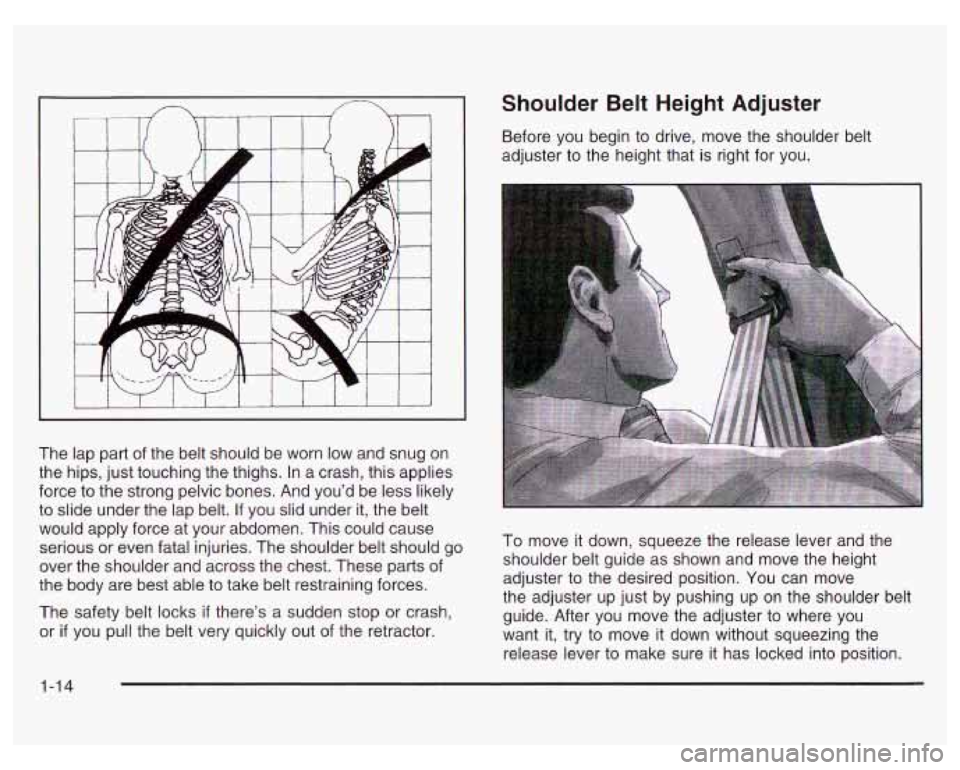
The lap part of the belt should be worn low and snug on
the hips, just touching the thighs. In a crash, this applies
force to the strong pelvic bones. And you’d be less likely
to slide under the lap belt.
If you slid under it, the belt
would apply force at your abdomen. This could cause
serious or even fatal injuries. The shoulder belt should go
over the shoulder and across the chest. These parts of
the body are best able to take belt restraining forces.
The safety belt locks
if there’s a sudden stop or crash,
or if you pull the belt very quickly out of the retractor.
Shoulder Belt Height Adjuster
Before you begin to drive, move the shoulder belt
adjuster to the height that is right for you.
To move it down, squeeze the release lever and the
shoulder belt guide as shown and move the height
adjuster to the desired position. You can move
the adjuster up just by pushing up on the shoulder belt
guide. After you move the adjuster to where you
want it, try to move it down without squeezing the
release lever to make sure it has locked into position.
1-14
Page 22 of 378
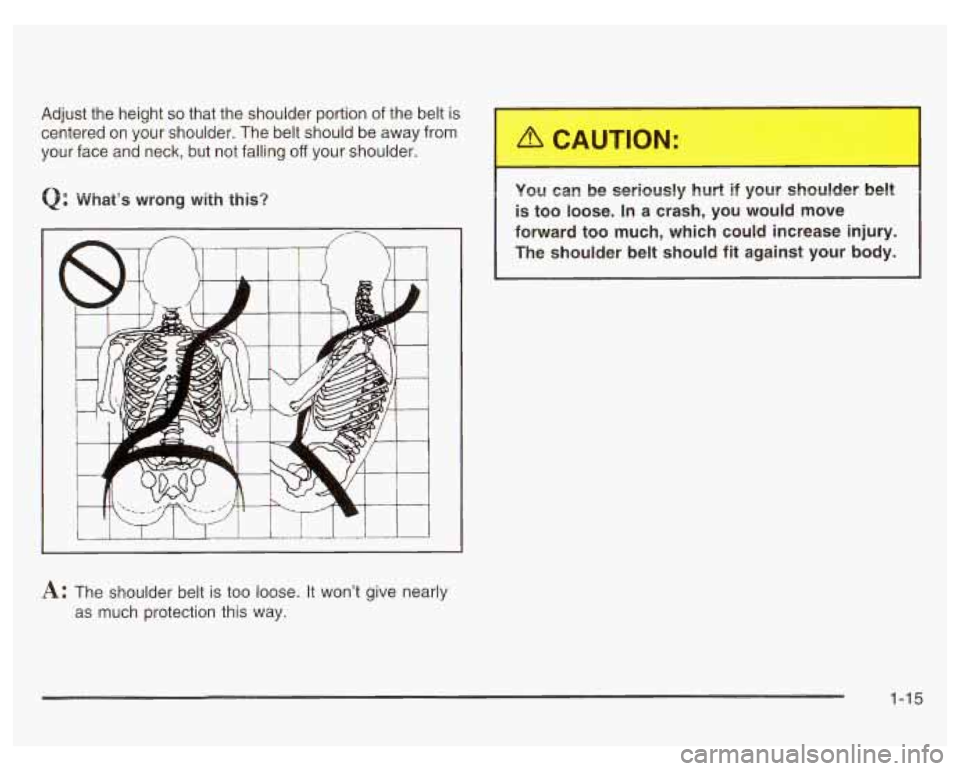
Adjust the height so that the shoulder portion of the belt is
centered on your shoulder. The belt should be away from
your face and neck, but not falling
off your shoulder.
Q: What’s wrong with this? You
can be serLaN,! hurt if your shoulder belt
is too loose. In
a crash, you would move
forward too much, which could increase injury.
The shoulder belt should fit against your body.
I
A: The shoulder belt is too loose. It won’t give nearly
as much protection this way.
1-15
Page 41 of 378
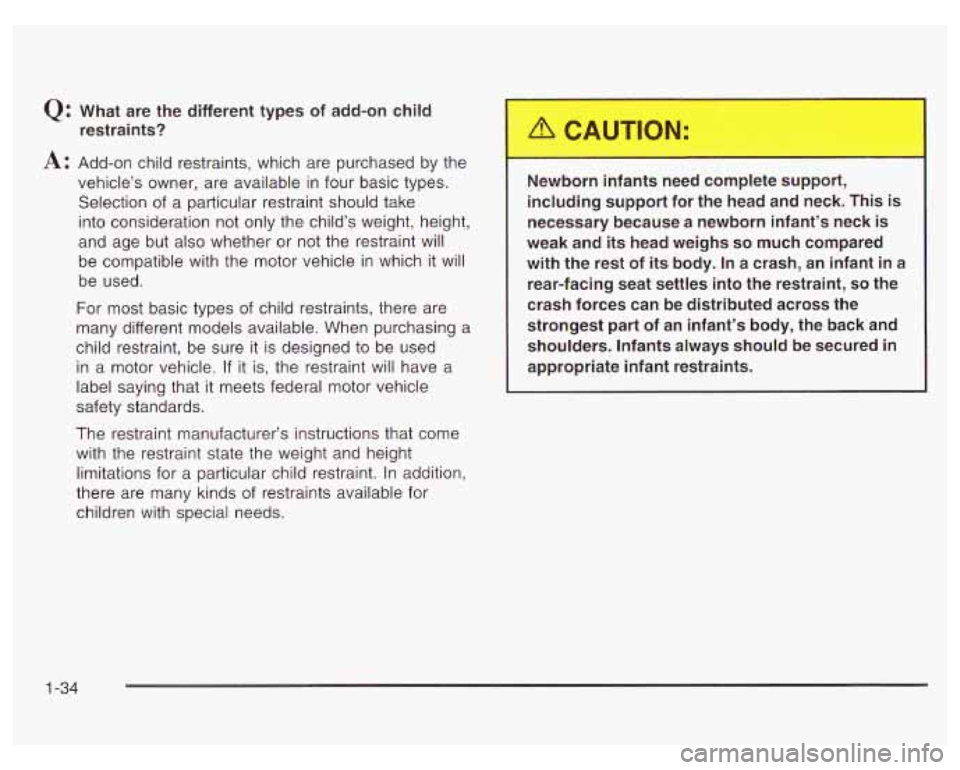
Q: What are the different types of add-on child restraints?
A: Add-on child restraints, which are purchased by the
vehicle’s owner, are available in four basic types.
Selection of a particular restraint should take
into consideration not only the child’s weight, height,
and age but also whether or not the restraint will
be compatible with the motor vehicle in which it will
be used.
For most basic types of child restraints, there are
many different models available. When purchasing a
child restraint, be sure it is designed to be used
in a motor vehicle. If it is, the restraint will have a
label saying that it meets federal motor vehicle
safety standards.
The restraint manufacturer’s instructions that come
with the restraint state the weight and height
limitations for a particular child restraint. In addition,
there are many kinds of restraints available for
children with special needs. Newborn infants
need complete support,
including support for the head and neck. This
is
necessary because a newborn infant’s neck is
weak and its head weighs
so much compared
with the rest of its body.
In a crash, an infant in a
rear-facing seat settles into the restraint,
so the
crash forces can be distributed across the
~ strongest part of an infant’s body, the back and
shoulders. Infants always should be secured in
appropriate infant restraints.
1-34
Page 139 of 378
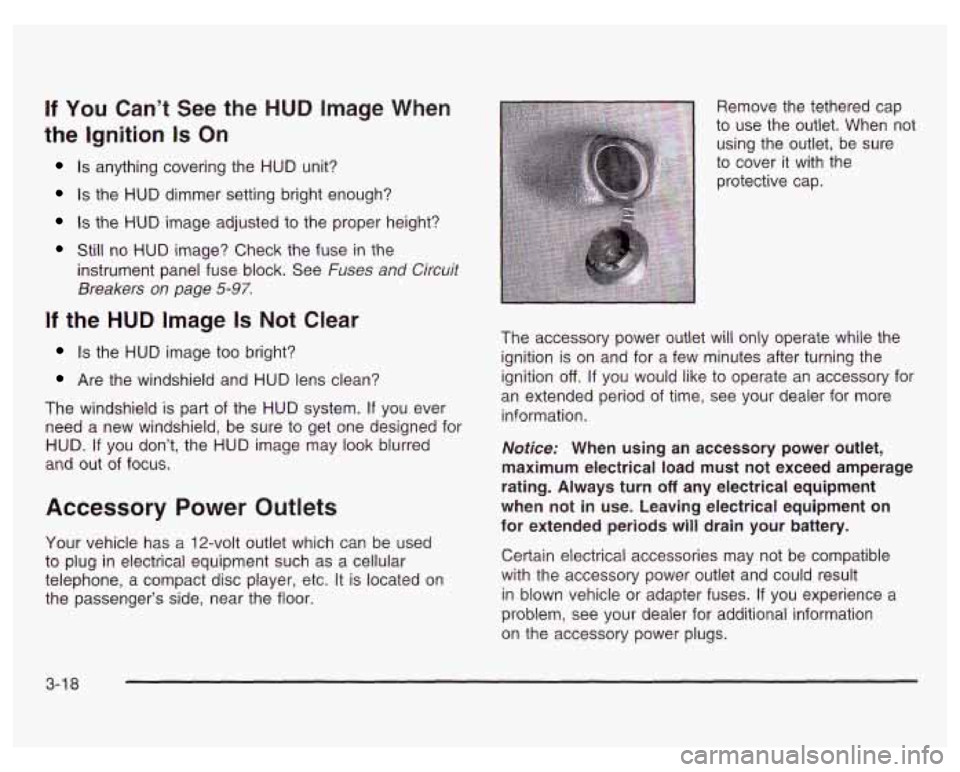
If You Can’t See the HUD Image When
the Ignition
Is On
Is anything covering the HUD unit?
Is the HUD dimmer setting bright enough?
Is the HUD image adjusted to the proper height?
Still no HUD image? Check the fuse in the
instrument panel fuse block. See Fuses and
Circuit
Breakers on page 5-97.
If the HUD Image Is Not Clear
Is the HUD image too bright?
Are the windshield and HUD lens clean?
The windshield is part of the HUD system.
If you ever
need a new windshield, be sure to get one designed for
HUD.
If you don’t, the HUD image may look blurred
and out of focus.
Accessory Power Outlets
Your vehicle has a 12-volt outlet which can be used
to plug in electrical equipment such as a cellular
telephone, a compact disc player, etc. It is located on
the passenger’s side, near the floor. Remove the tethered cap
to use the outlet. When not
using the outlet, be sure
to cover it with the
protective cap.
The accessory power outlet will only operate while the
ignition is on and for a few minutes after turning the
ignition
off. If you would like to operate an accessory for
an extended period of time, see your dealer for more
information.
Notice: When using an accessory power outlet,
maximum electrical load must not exceed amperage
rating. Always turn
off any electrical equipment
when not in use. Leaving electrical equipment on
for extended periods will drain your battery.
Certain electrical accessories may not be compatible
with the accessory power outlet and could result
in blown vehicle or adapter fuses.
If you experience a
problem, see your dealer for additional information
on the accessory power plugs.
3-1 8
Page 299 of 378

If you need to replace any of your wheels, wheel bolts
or wheel nuts, replace them only with new
GM
original equipment parts. This way, you will be sure to
have the right wheel, wheel bolts and wheel nuts
for your vehicle.
Using the wrong replacement wheels, wheel
bolts or wheel nuts on your vehicle can be
dangerous.
It could affect the braking and
handling
of your vehicle, make your tires lose
air and make you lose control. You could have
a collision
in which you or others could be
injured. Always use the correct wheel, wheel
bolts and wheel
nuts for replacement.
Notice: The wrong wheel can also cause problems
with bearing life, brake cooling, speedometer or odometer calibration, headlamp aim, bumper height.
vehicle ground clearance and tire or tire chain clearance to the body and chassis.
See Changing a Flat
Tire on page 5-76 for more
information.
Used Replacement Wheels
I
Puttin, -1 used wheel on your vehicle is
dangerous. You can’t know how it’s been used
or how far
it’s been driven. It could fail suddenly
and cause a crash.
If you have to replace a
wheel, use a new
GM original equipment wheel.
5-74
Page 371 of 378
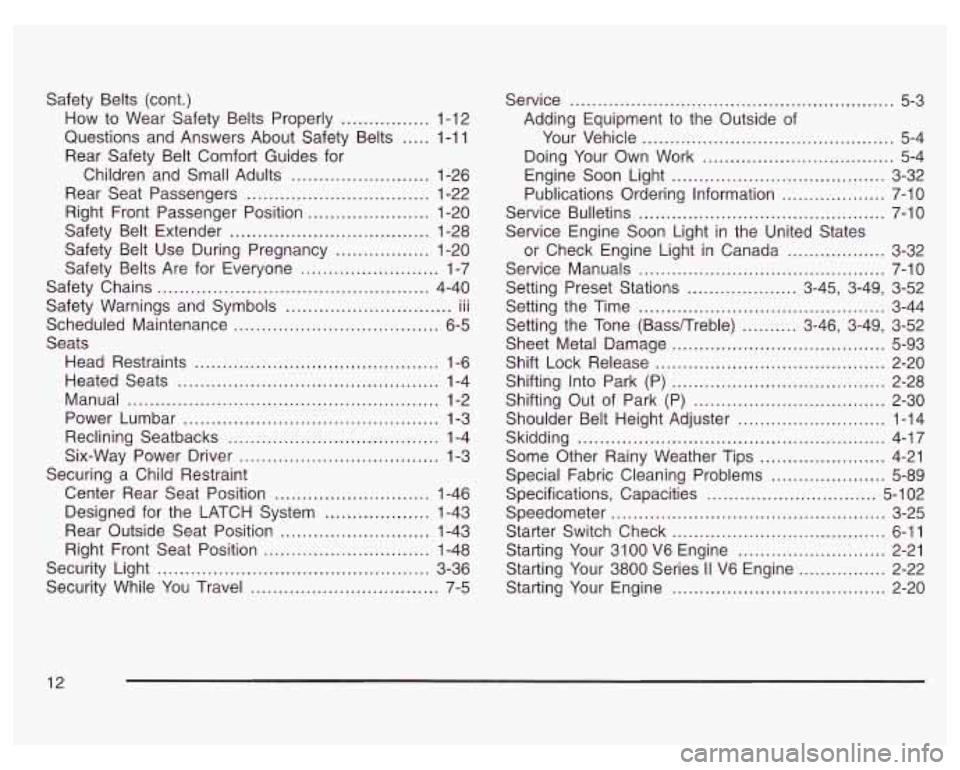
Safety Belts (cont.)
How to Wear Safety Belts Properly
................ 1-12
Rear Safety Belt Comfort Guides for
Children and Small Adults
......................... 1-26
Rear Seat Passengers
................................. 1-22
Right Front Passenger Position
...................... 1-20
Safety Belt Extender
.................................... 1-28
Safety Belt Use During Pregnancy
................. 1-20
Safety Belts Are for Everyone
......................... 1-7
Safety Chains
................................................. 4-40
Safety Warnings and Symbols
.............................. III
Scheduled Maintenance ..................................... 6-5
Seats Head Restraints
............................................ 1-6
Heated Seats
............................................... 1-4
Manual
........................................................ 1-2
Power Lumbar
.............................................. 1-3
Reclining Seatbacks
...................................... 1-4
Six-Way Power Driver
.................................... 1-3
Center Rear Seat Position
............................ 1-46
Designed for the LATCH System
................... 1-43
Rear Outside Seat Position
........................... 1-43
Right Front Seat Position
.............................. 1-48
Security Light
................................................. 3-36
Questions
and Answers About Safety Belts
..... 1-1 1
...
Securing a Child Restraint
Security While You Travel
.................................. 7-5 Service
....................................................... 5-3
Adding Equipment to the Outside of
Your Vehicle
.............................................. 5-4
Doing Your Own Work
................................... 5-4
Engine Soon Light
....................................... 3-32
Publications Ordering Information
................... 7-10
Service Bulletins
............................................. 7-10
Service Engine Soon Light in the United States
or Check Engine Light in Canada
.................. 3-32
Service Manuals
............................................. 7-10
Setting Preset Stations
.................... 3-45, 3-49, 3-52
Setting the Time
............................................. 3-44
Setting the Tone (BassTTreble)
.......... 3-46, 3-49, 3-52
Sheet Metal Damage
....................................... 5-93
Shift Lock Release
.......................................... 2-20
Shifting Into Park (P)
....................................... 2-28
Shifting Out of Park (P)
................................... 2-30
Shoulder Belt Height Adjuster
........................... 1-14
Skidding
........................................................ 4-17
Some Other Rainy Weather Tips
....................... 4-21
Special Fabric Cleaning Problems
..................... 5-89
Specifications, Capacities
............................... 5-1 02
Speedometer
.................................................. 3-25
Starter Switch Check
....................................... 6-11
Starting Your 3100
V6 Engine ........................... 2-21
Starting Your 3800 Series
II V6 Engine ................ 2-22
Starting Your Engine
....................................... 2-20
12